Legitimists
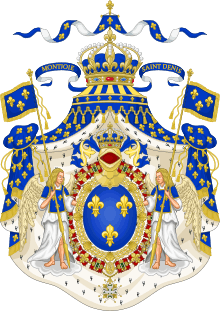
| Part of a series of articles on |
| Monarchy |
|---|
.svg.png) |
|
Central concepts |
|
History |
| Politics portal |
The Legitimists (French: Légitimistes) are royalists in France who adhere to the rights of dynastic succession of the descendants of the elder branch of the Bourbon dynasty, which was overthrown in the 1830 July Revolution.[1] They reject the claim of the July Monarchy of 1830–1848, whose king was a member of the junior Orléans line of the Bourbon dynasty. Following the movement of Ultra-royalists during the Bourbon Restoration of 1814, legitimists came to form one of the three main right-wing factions in France, which was principally characterized by its counter-revolutionary views. The other two right-wing factions are, according to historian René Rémond, the Orléanists and the Bonapartists.
Legitimists hold that the king of France must be chosen according to the traditional rules of succession based in the Salic law. When the direct line of Charles X became extinct in 1883 with the death of his grandson Henri, Count of Chambord, the most senior heir to the throne under these traditional rules was Juan, Count of Montizón, a descendent of Louis XIV via his grandson Philip V of Spain.
History
The Bourbon Restoration (1814–1830)
Following the Bourbon Restoration in 1814, a strongly restricted census suffrage sent to the Chamber of Deputies an ultra-royalist majority in 1815–1816 (la Chambre introuvable) and from 1824 to 1827. Called as such because they were "more royalist than the king" (plus royalistes que le roi), the Ultras were thus the dominant political faction under Louis XVIII (1815–1824) and Charles X (1824–1830). Opposed to the constitutional monarchy of Louis XVIII and to the limitation of the sovereign's power, they hoped to restore the Ancien Régime and cancel the rupture created by the French Revolution. By the same token, Ultras opposed all liberal, republican and democratic ideas. While Louis XVIII hoped to moderate the "restoration" of the Ancien Régime in order to make it acceptable to the population, the Ultras would never abandon the dream of an integral restoration, even after the 1830 July Revolution which set the Orleanist branch on the throne and the Ultras back to their castles in the countryside and to private life. Their importance during the Restoration was in part due to electoral laws which largely favored them (on one hand, a Chamber of Peers composed of hereditary members; on the other hand, a Chamber of Deputies elected under a heavily restricted census suffrage, which permitted approximately 100,000 Frenchmen to vote).
Louis XVIII's first ministers, who included Talleyrand, the duc de Richelieu and Decazes, were replaced by the Chambre introuvable dominated by the Ultras. Louis XVIII finally decided to dissolve this chaotic assembly, but the new liberals who replaced them were no easier to govern. After the 1820 assassination of the duc de Berry, the ultra-reactionary son of the comte d'Artois (Louis XVIII's brother and future Charles X), and a short interval during which the duc de Richelieu governed, the Ultras were back in government, headed by the comte de Villèle.
The death in 1824 of the moderate Louis XVIII emboldened the Ultra faction. In January 1825, Villèle's government passed the Anti-Sacrilege Act, which punished by death the theft of sacred vessels (with or without consecrated hosts). This "anachronistic law" (Jean-Noël Jeanneney) was in the end never applied (except on a minor point) and repealed in the first months of Louis Philippe I's reign (1830–1848). The Ultras also wanted to create courts to punish Radicals, and passed laws restricting freedom of the press.
After the 1830 July Revolution replaced the Bourbons with the more liberal Orleanist branch, the Ultras' influence declined, although it survived until at least the 16 May 1877 crisis and 1879, and even longer. They softened their views and made the restoration of the House of Bourbon their main aim. From 1830 on they became known as Legitimists.
Legitimists under the July Monarchy (1830–1848)
During the July Monarchy of 1830 to 1848, when the junior Orleanist branch held the throne, the Legitimists were politically marginalized, many withdrawing from active participation in political life. The situation was complicated before 1844 by debate as to who the legitimate king was: Charles X and his son Louis-Antoine the Dauphin had both abdicated during the 1830 Revolution in favor of Charles's young grandson, Henri comte de Chambord. Until the deaths of Charles X and his son in 1836 and 1844, respectively, many Legitimists continued to recognize each of them in turn as the rightful king, ahead of Chambord.
Legitimists under the Second Republic and the Second Empire (1848–1871)
The fall of King Louis Philippe I in 1848 led to a strengthening of the Legitimist position. Although the childlessness of Chambord weakened the hand of the Legitimists, they came back into political prominence during the Second Republic. Legitimists joined with Orleanists to form the Party of Order which dominated parliament from the elections of May 1849 until Bonaparte's coup on December 2, 1851. They formed a prominent part of Odilon Barrot's ministry from December 1848 to November 1849, and in 1850 were successful in passing the Falloux Law which brought the Catholic Church back into secondary education.
Through much of this time there was discussion of "fusion" with the Orleanist Party so that the two could effect a monarchical restoration. This prospect prompted several sons of Louis Philippe to declare their support for Chambord. But fusion was not actually achieved, and after 1850 the two parties again diverged. The most committed Orleanists supported the candidacy of Louis Philippe's third son, the Prince de Joinville, for the presidency, while the legitimists largely supported allowing Bonaparte to run for a second term. In spite of this support for Bonaparte's ambitions, they opposed his scheme to restore universal suffrage in the last months of 1851, and their leaders were, like those of the Orleanists, arrested during Bonaparte's coup.
The period of the Second Empire saw the Legitimists once again cast out of active political life.
Legitimists under the Third Republic (1871–1940)
Nevertheless, the Legitimists remained a significant party within elite opinion, attracting support of the larger part of the ancien régime aristocracy. After the Siege of Paris in 1870 and the 1871 Paris Commune, the Legitimists returned for one final time to political prominence. The 8 February 1871 elections, held under universal manhood suffrage, gave the National Assembly of France a royalist majority supported by the provinces, while all the Parisian deputies were Republican. This time, the Legitimists were able to agree with the Orleanists on a program of fusion, largely because of the growing likelihood that the count of Chambord would die without children. The liberal Orleanists agreed to recognize Chambord as king, and the Orleanist claimant himself, Louis-Philippe Albert d'Orléans (1838–1894), count of Paris, recognized Chambord as head of the French royal house. In return, Legitimists in the Assembly agreed that, should Chambord die childless, Philippe d'Orléans would succeed him as king. Unfortunately for French monarchism, Chambord's refusal to accept the Tricolor as the flag of France and to abandon the fleur-de-lys, symbol of the Ancien régime, made restoration impossible until after his death in 1883, by which time the monarchists had long since lost their parliamentary majority due to the 16 May 1877 crisis. The death of Chambord effectively dissolved the parti légitimiste as a political force in France.
Affected by sinistrisme, few conservatives explicitly called themselves right wing during the Third Republic: it became a term associated with the Counter-Revolution and anti-republican feelings, and by the 1900s (decade) was reserved for radical groups. Those Legitimists who had rallied to the Republic in 1893, after the comte de Chambord's death ten years before, still called themselves Droite constitutionnelle or républicaine (Constitutional or Republican Right). But they changed their name in 1899, and entered the 1902 elections under the name Action libérale. By 1910, the only group which openly claimed descent from the right wing gathered only nostalgic royalists, and from 1924 on the term "right wing" practically vanished from the parliamentary right's glossary.
By this time, the vast majority of legitimists had retired to their country chateaux and abandoned the political arena. Although the Action française remained an influential movement throughout the 1930s, its motivations for the restoration of monarchy were quite distinct from older Legitimists' views, and Maurras' instrumental use of Catholicism set them at odds. Thus, Legitimists participated little in the political events of the 1920s and 1930s, in particular in the 6 February 1934 riots organized by far right leagues. The royalist aristocrats clearly distinguished themselves from the new ultra right, influenced by the emerging movements of fascism and nazism. However, Legitimists joined Maurras in celebrating the fall of the Third Republic after the 1940 Battle of France as a "divine surprise", and many of them entered Pétain's Vichy administration as a golden opportunity to impose a reactionary program in occupied France.
Legitimists under Vichy and after World War II (1940–Present)
Legitimists returned to prominence during Vichy France, according to historian René Rémond's studies of the right-wing factions in France. Some would also support the OAS during the Algerian War (1954–62). Marcel Lefebvre's Society of Saint Pius X, founded in 1970, especially in France, shares aspects with the legitimist movement, according to Rémond.
As of 2006, some remain strongly attached to the traditionalist wing of the Catholic Church. Such Legitimists are strongly opposed to the proposed European Constitution and anything else perceived as threatening the independence of France. Among French Legitimists, there is diversity of opinion. Some tend to gather around Traditionalist Catholic places, such as the Saint-Nicolas-du-Chardonnet church in Paris, or around far-right parties such as Jean-Marie Le Pen's Front National or de Villiers' Mouvement pour la France.
Carlism
A remnant, known as the blancs d'Espagne ("Whites of Spain"), by repudiating Philip V's renunciation of the French throne as ultra vires and contrary to the Fundamental French monarchical law, upheld the rights of the eldest branch of the Bourbons, represented as of 1883 by the Carlist pretender to the Spanish throne. This group was initially minuscule, but began to grow larger after World War II due both to the political leftism of the Orleanist Pretender, Henri, comte de Paris, and to the active efforts of the claimants of the elder line—Jaime, Duke of Segovia, the disinherited second son of Alfonso XIII of Spain, and his son, Alfonso, Duke of Anjou and Cádiz—to secure legitimist support, such that by the 1980s, the elder line had fully reclaimed for its supporters the political title of "Legitimists". This means that the current legitimist claimant is the Spanish-born Louis-Alphonse de Bourbon (Luis-Alfonso de Borbón y Martínez Bordiú), styled duc d'Anjou, whom the French legitimists consider to be the de jure king of France under the name "Louis XX". A 1987 attempt[2] by the Orleanist heir (and other Bourbons, none of the elder branch) to contest Louis-Alphonse's use of the Anjou title[3] and to deny him use of the plain coat of arms of France was dismissed by the French courts in March 1989 for lack of jurisdiction (the courts did not address the merits of the claims). The duc d'Anjou, a French citizen through his paternal grandmother, is generally recognised as the senior legitimate representative of the House of Capet.
Dynastic arguments
The Legitimist arguments on the succession to the French throne is based on the fundamental laws of the Ancien Régime which was formed in the early centuries of the Capetian monarchy.
According to these rules, the succession to the throne is hereditary, passing by primogeniture in combination with the Salic law (which excludes females and descendants who wish to claim the throne through the distaff line). The King must also be Catholic. Unlike the other requirements, which are fixed, this can be overcome by conversion.
Among the further tenets of the legitimist position are the following:
- Continuity (or immediacy) of the Crown: upon the death of a monarch, his heir automatically and immediately becomes king, without the need of any formal act of investiture, and even if political circumstances would not allow him to actually take power.
- Unavailability (or inalienability) of the crown: the crown is not the personal property of the king; therefore, nobody, not even the king himself, can alter the line of succession, through an act of abdication or renunciation, or by appointing an heir of his own choosing. This argument is crucial for the legitimists regarding the continuing validity of the rights of succession of the Spanish line of Philip V and his descendants. According to this view, Philip's renunciation of his rights of succession in France in the Treaty of Utrecht of 1713 was null and void, and therefore his descendants still retain their claim to the French throne ahead of the Orléans line.
It has been a point of contention within the legitimist camp to what extent French nationality constitutes a precondition for royal succession. While adherents of the Spanish (Anjou) line argue that princes of foreign nationality can still succeed to the French crown,[4] others hold that French nationality of both the claimant and his ancestors is a requirement.[5][6]
List of Legitimist claimants to French throne
Those Legitimists who did not accept the Orléanist line as the successors of Chambord argued that the renunciation of the French throne by Philip V of Spain, second grandson of Louis XIV, was invalid, and that in 1883 (when Chambord died childless) the throne had passed to Philip V's male heirs. This line had also lost the Spanish throne in favor of the non-Salic heiress Isabella II, and were known as the Carlist pretenders in Spain. The French claim was reunited with that of the Isabelline Spanish line when the Carlist branch died out in 1936, though Alfonso XIII of Spain had by that time been dethroned by the Second Spanish Republic. The French and Spanish claims separated again at Alfonso's death, as his eldest surviving son Infante Jaime renounced his claim to the Spanish throne due to physical disability and, some years later, asserted a claim to the French succession based on Legitimist principles. The present French Legitimist claimant is descended from Jaime, while the present King of Spain is descended from his younger brother, Don Juan.
In the 1870s the rival Legitimist and Orléanist claimants agreed, for the sake of the French monarchy, to end their rivalry. Philippe d'Orléans, the comte de Paris and grandson of Louis Philippe I, accepted the prior claim to the throne of the comte de Chambord. Chambord, who remained childless, in turn acknowledged that Philippe would claim the right to succeed him as heir, and after his death many Legitimists accepted the descendants of Philippe as the rightful pretender.[7][8]
Those who accept the Legitimist-Orleanist line (also known as the Unionist claim) consider that Philip V of Spain and his descendants validly renounced their rights to the French Throne in the Peace of Utrecht, and that the Treaty of Utrecht blocks the right to the Crown of France from passing through their line.
According to this point of view, the proper line follows the one above from Louis XVI through Chambord ("Henry V"), but thereafter follows the Orléanist line, from Philippe d'Orléans ("Philippe VII") to the present.
French line (1792–present)
| Claimant | Portrait | Birth | Marriages | Death |
|---|---|---|---|---|
| Louis XVI 1792–1793 |
 |
23 August 1754, Versailles son of Dauphin Louis and Marie-Josèphe of Saxony |
Marie Antoinette of Austria 16 May 1770 4 children |
21 January 1793 Paris aged 38 |
| Louis-Charles, Dauphin of France (Louis XVII) 1793–1795 |
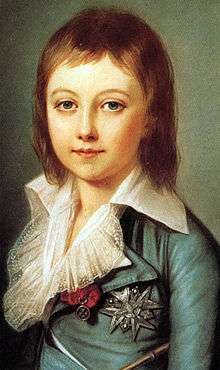 |
27 March 1785, Versailles son of Louis XVI and Marie Antoinette of Austria |
never married | 8 June 1795 Paris aged 10 |
| Louis XVIII 1795–1824 (King of France 1814–1815, 1815–1824) |
 |
17 November 1755, Versailles son of Dauphin Louis and Marie-Josèphe of Saxony |
Marie Josephine Louise of Savoy 14 May 1771 No children |
16 September 1824 Paris aged 68 |
| Charles X 1824–1836 (King of France 1824–1830) |
 |
9 October 1757, Versailles son of Dauphin Louis and Marie-Josèphe of Saxony |
Marie Thérèse of Savoy 16 November 1773 3 children |
6 November 1836 Gorizia aged 79 |
| Louis-Antoine, Duke of Angoulême (Louis XIX) 1836–1844 |
 |
6 August 1775, Versailles son of Charles X and Marie Thérèse of Savoy |
Marie-Thérèse-Charlotte of France 10 June 1799 No children |
3 June 1844 Gorizia aged 68 |
| Henri, Count of Chambord (Henry V) 1844–1883 |
 |
29 September 1820, Paris son of Charles Ferdinand, Duke of Berry and Caroline Ferdinande Louise of Two Sicilies |
Marie Thérèse of Austria-Este 7 November 1846 No children |
24 August 1883 Gorizia aged 63 |
| Juan, Count of Montizón (John III) 1883–1887 |
 |
15 May 1822, Aranjuez son of Carlos, Count of Molina and Maria Francisca of Portugal |
Beatrix of Austria-Este 6 February 1847 2 children |
21 November 1887 Hove aged 65 |
| Carlos, Duke of Madrid (Charles XI) 1887–1909 |
 |
30 March 1848, Ljubljana son of Juan, Count of Montizón and Beatrix of Austria-Este |
Margarita of Bourbon-Parma 4 February 1867 5 children Berthe de Rohan 28 April 1894 No children |
18 July 1909 Varese aged 61 |
| Jaime, Duke of Madrid (James I) 1909–1931 |
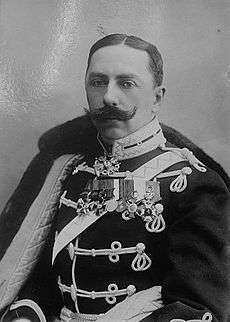 |
27 June 1870, Vevey son of Carlos, Duke of Madrid and Margarita of Bourbon-Parma |
never married | 2 October 1931 París aged 61 |
| Alfonso Carlos of Bourbon, Duke of San Jaime (Charles XII) 1931–1936 |
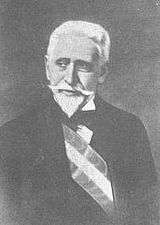 |
12 September 1849 London son of Juan, Count of Montizón and Beatrix of Austria-Este |
Maria das Neves of Portugal 26 April 1871 1 child |
29 September 1936 Vienna aged 87 |
| Alfonso XIII of Spain (Alphonse I) 1936–1941 |
 |
17 May 1886, Madrid son of Alfonso XII of Spain and Maria Christina of Austria |
Victoria Eugenie of Battenberg 31 May 1906 7 children |
28 February 1941 Rome aged 54 |
| Infante Jaime, Duke of Segovia (Henry VI) 1941–1975 |
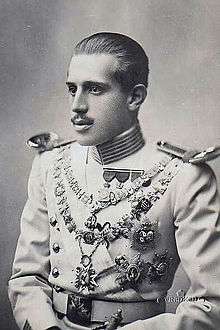 |
23 June 1908, Segovia son of Alfonso XIII of Spain and Victoria Eugenie of Battenberg |
first marriage Emmanuelle de Dampierre 4 March 1935 Rome (divorced 6 May 1947)[9] 2 children - - - - - - - - - - - - - - second marriage (civil only, not recognized by the Church) Charlotte Luise Auguste Tiedemann 3 August 1949 Vienna No children |
20 March 1975 St. Gallen aged 67 |
| Alfonso, Duke of Anjou and Cádiz (Alphonse II) 1975–1989 |
 |
20 April 1936, Rome son of Jaime, Duke of Segovia and Emmanuelle de Dampierre |
María del Carmen Martínez-Bordiú y Franco 8 March 1972 Royal Palace of El Pardo (divorced 1982/annulled 1986) 2 children |
30 January 1989 Beaver Creek aged 53 |
| Louis Alphonse, Duke of Anjou (Louis XX) 1989–present |
 |
25 April 1974, Madrid son of Alfonso, Duke of Anjou and Cádiz and María del Carmen Martínez-Bordiú y Franco |
María Margarita Vargas Santaella 5 November 2004 Caracas 3 children |
Electoral results
These are the results for broadly Legitimist parties in French national elections.
| Council of Five Hundred | ||||||
| Election year | # of overall votes |
% of overall vote |
# of overall seats won |
+/– | Leader | |
|---|---|---|---|---|---|---|
| 1795 | unknown (#3) | ? | 33 / 150 |
|
| |
| 1799 | unknown (#3) | ? | 80 / 500 |
|
| |
| Chamber of Deputies | ||||||
| 1815 | unknown (#1) | ? | 350 / 400 |
|
| |
| 1816 | unknown (#2) | ? | 92 / 258 |
|
| |
| 1820 | unknown (#3) | ? | 160 / 434 |
|
| |
| 1824 | unknown (#1) | ? | 413 / 430 |
|
| |
| 1827 | unknown (#2) | ? | 180 / 430 |
|
| |
| 1830 | unknown (#2) | ? | 104 / 378 |
|
| |
| 1831 | unknown (#2) | ? | 104 / 460 |
|
| |
| 1834 | unknown (#4) | ? | 15 / 460 |
|
| |
| 1837 | unknown (#6) | ? | 15 / 460 |
|
| |
| 1839 | unknown (#3) | ? | 20 / 460 |
|
| |
| 1842* | unknown (#1) | ? | 266 / 460 |
|
| |
| 1846* | unknown (#1) | ? | 290 / 460 |
|
| |
| National Assembly | ||||||
| 1848 | unknown (#2) | ? | 200 / 880 |
|
| |
| 1849** | unknown (#1) | ? | 450 / 750 |
|
| |
| National Assembly (French Third Republic) | ||||||
| 1871 | unknown (#2) | ? | 182 / 675 |
|
| |
| 1876* | unknown (#7) | ? | 24 / 553 |
|
| |
| 1877* | unknown (#3) | ? | 44 / 521 |
|
| |
- Notes
- In the Conservatives group.
- In the Party of Order.
See also
- French dynastic disputes
- Succession to the French throne
- René Rémond
- Bonapartism
- Orleanism
- Ultra-royalists
- Bourbon Restoration
- France in the nineteenth century
- Parti de l'Ordre
- Line of succession to the French throne (Legitimist-Anjou)
- Line of succession to the French throne (Legitimist-Orléanist)
- Democratic Rally (France) - A legitimist political party in France.
References
- ↑ Atkin, Nicholas; Biddiss, Michael; Tallett, Frank, eds. (2011). "Legitimism". The Wiley-Blackwell Dictionary of Modern European History Since 1789. Malden: Wiley-Blackwell. p. 239.
- ↑ "Lawsuit brought by the comte de Clermont against the duc d'Anjou (1988-89)". Heraldica.org. Retrieved 2014-08-02.
- ↑ "Apanages in the French Monarchy". Heraldica.org. 2010-04-22. Retrieved 2014-08-02.
- ↑ Guy Stair Sainty. "The French Legitimist Case".
- ↑ Société d'Histoire Générale et d'Histoire Diplomatique: Société d'Histoire Diplomatique. Revue d'Histoire Diplomatique, volume 3. Éditions A. Pedone, 1889. Paris. P. 190. In French. Retrieved 11 October 2011.
- ↑ Velde, François. . The Nationality Requirement in the French Succession laws 31 December 2004. Retrieved 11 October 2011.
- ↑ Sedgwick, Alexander (1965). The ralliement in French politics, 1890-1898. Cambridge, MS: Harvard University Press. p. 12.
- ↑ Henri-Scipion-Charles, marquis de Dreux-Brézé
- ↑ McNaughton, C Arnold (1973). The Book of Kings. 1. London: Garnstone Press. p. 432. ISBN 978-0-8129-0280-8.
External links
| Wikisource has the text of the 1911 Encyclopædia Britannica article Legitimists. |